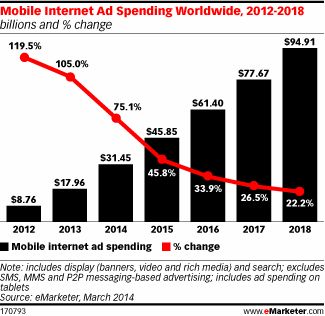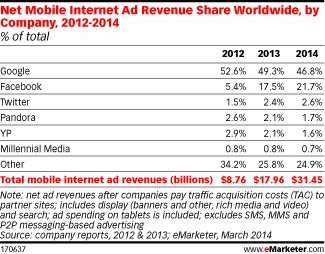Global mobile ad spending is expected to reach an all-time high next year, capping nearly $45 billion, according to numbers from eMarketer. You’re not the only one to see that’s a lot higher than usual, and most of that increase comes in the form of new advertising that manages to organically blend in with content on pages, utilizing whatever technological advances can be supplied — including larger device screens, according to Adweek.

Interstitials could play the largest part in this new ad approach, mainly due to the fact that they’ve been successful thus far this year, with a “logical break point” for users to interact with, according to Google’s Jonathan Alferness. These ads managed to gain a better rate of engagement, with users looking at them for a greater period of time. Interstitials alone have managed to jump a whopping 43 percent between the first two quarters of this year, per AppFlood.
So what makes them tick Well, it’s a way these ads connect with the brains of users, utilizing a slick form of psychology. Interstitials have a way of connecting with users similar to ads from the older days of television, with something that feels more like an additional treat for viewers, rather than something to simply ignore or skip past.
Jane E. Raymond, professor off experimental consumer psychology at the University of Wales in Bangor, explained that “we actually process information in gulps. The brain goes out, grabs a bit of information, digests it, then grabs another bit.”
In addition, a study published in Psychology Today showed that, in a research project involving 300 students age 8 to 20, the general focus only spans about three minutes at a time. These students managed to look for various means of distraction, or something that would get their attention in that time frame. The introduction of an interstitial offers a form of interaction, if only temporary, and certainly something more well-meaning than a typically flat message.

An “isolation effect” can also play a huge part with interstitials, as people tend to recall things that stand out on their own end, even if they’re unexpected.
When it comes to how an interstitial can be effective, Madelijn Strick, a psychology researcher from the Netherlands, explained that two things are needed to make something like that work: a message that comes across the right way, usually with a sense of humor, and a delivery system, such as the Interscroller interstitial, that feels more natural and non-obtrusive.
Don’t be surprised to see more and more interstitials introduced in the market by this time next year.

